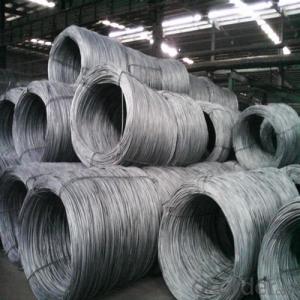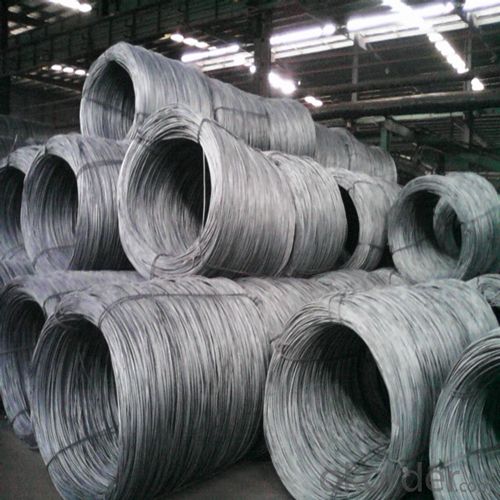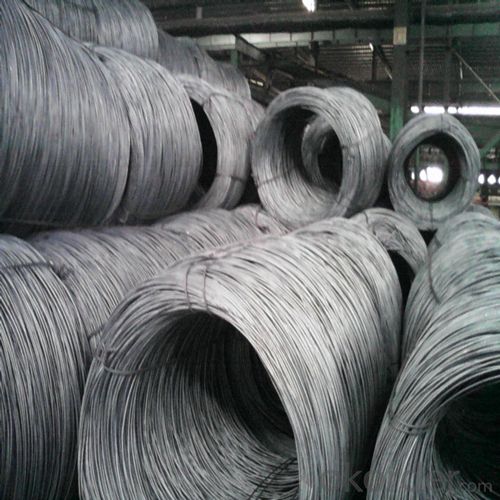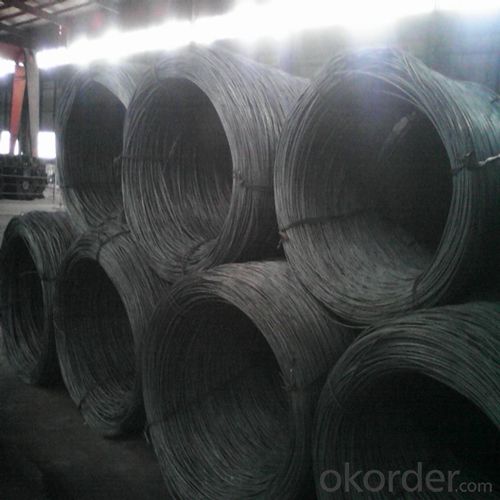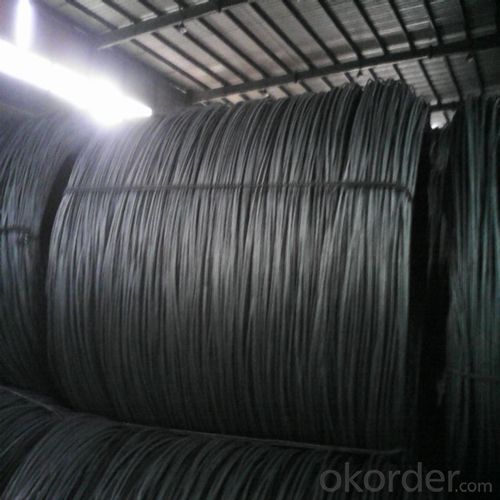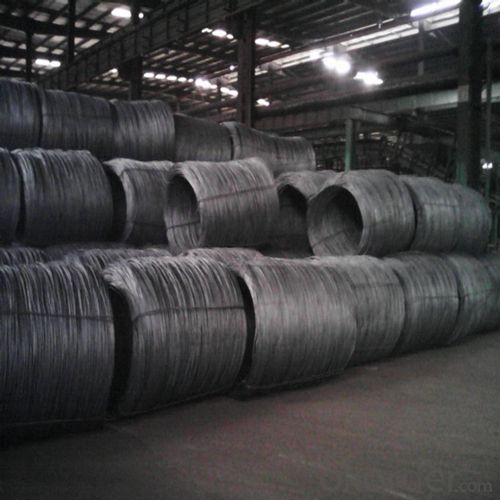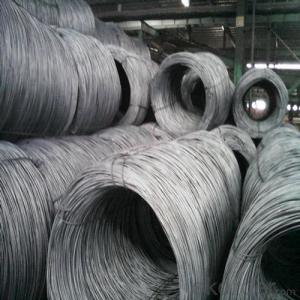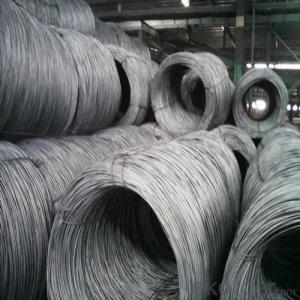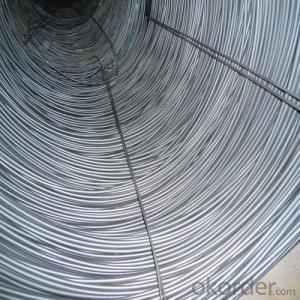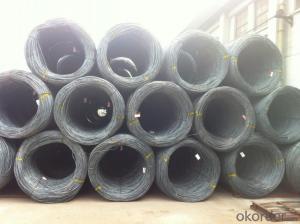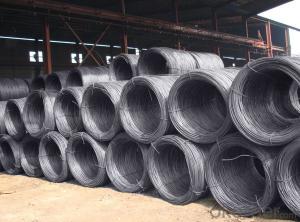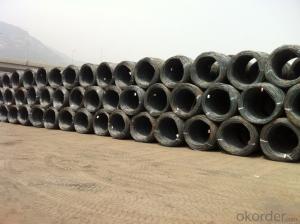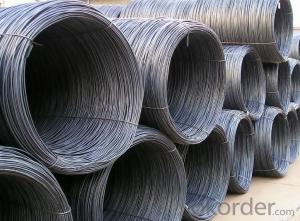Hot Rolled Wire Rod SAE1008 SAE1006 SAE1018 High Quality
- Loading Port:
- Tianjin
- Payment Terms:
- TT OR LC
- Min Order Qty:
- 1000 m.t.
- Supply Capability:
- 30000 m.t./month
OKorder Service Pledge
OKorder Financial Service
You Might Also Like
Product Description:
OKorder is offering Hot Rolled Wire Rod SAE1008 SAE1006 SAE1018 High Quality Good Price at great prices with worldwide shipping. Our supplier is a world-class manufacturer of steel, with our products utilized the world over. OKorder annually supplies products to European, North American and Asian markets. We provide quotations within 24 hours of receiving an inquiry and guarantee competitive prices.
Product Applications:
Hot Rolled Wire Rod SAE1008 SAE1006 SAE1018 High Quality are ideal for structural applications and are widely used in the construction of buildings and bridges, and the manufacturing, petrochemical, and transportation industries.
Product Advantages:
OKorder's Hot Rolled Wire Rod SAE1008 SAE1006 SAE1018 High Quality are durable, strong, and resist corrosion.
Main Product Features:
· Premium quality
· Prompt delivery & seaworthy packing (30 days after receiving deposit)
· Corrosion resistance
· Can be recycled and reused
· Mill test certification
· Professional Service
· Competitive pricing
Product Specifications:
Steel Grade: Q195/235, SAE1006-1018B Standard: ASTM, GB
Diameter: 5.5mm, 6.5mm, 7mm,8mm,9mm,10mm,12mm,14mm
Diameter tolerance: +/-0.3mm 6.5mmcan be drawing into 2mm/8.0mmcan be drawing into 3mm
Type: Drawn Wire Brand Name: HSKY Technique: Hot Rolled Place of Origin: China Mainland
Chemical Composition:
Please kindly find our chemistry of our material based on SAE1006B as below for your information
| Grade | Chemical Composition (%) | |||||
| C | Mn | S | P | Si | B | |
| SAE1006B | 0.03~O.07 | 0.32max | 0.045max | 0.040max | 0.30max | 0.0008min |
| Mechanical properties | ||||||
| Yield strength(N/mm2) | Tensile strength(N/mm2) | Elongation (%) | ||||
| 250-280 | 350-380 | ≥32 | ||||
FAQ:
Q1: Why buy Materials & Equipment from OKorder.com?
A1: All products offered byOKorder.com are carefully selected from China's most reliable manufacturing enterprises. Through its ISO certifications, OKorder.com adheres to the highest standards and a commitment to supply chain safety and customer satisfaction.
Q2: How do we guarantee the quality of our products?
A2: We have established an advanced quality management system which conducts strict quality tests at every step, from raw materials to the final product. At the same time, we provide extensive follow-up service assurances as required.
Q3: How soon can we receive the product after purchase?
A3: Within three days of placing an order, we will begin production. The specific shipping date is dependent upon international and government factors, but is typically 7 to 10 workdays.
Images:
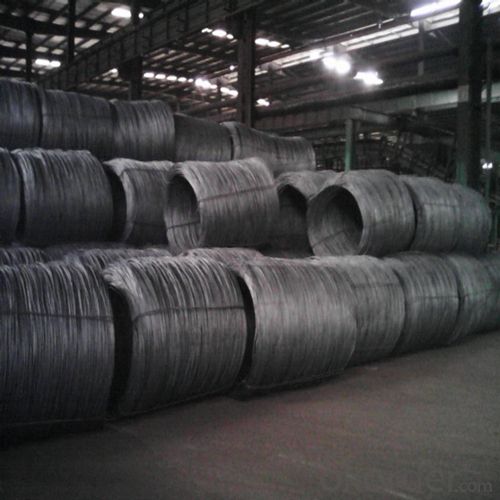
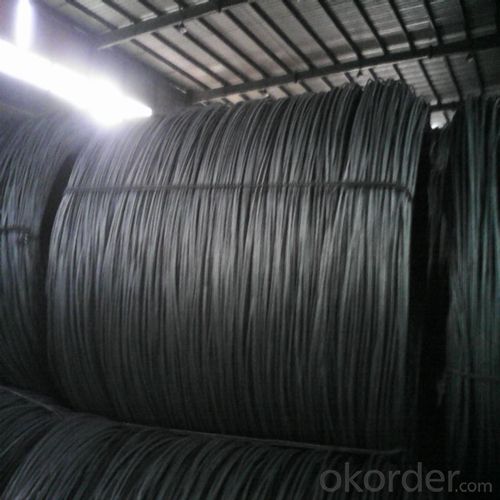
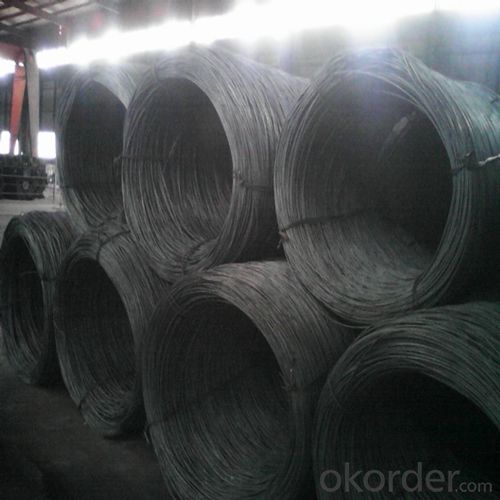
- Q: What are the advantages of using steel wire rod over other materials?
- There are several advantages of using steel wire rod over other materials. Firstly, steel wire rod offers exceptional strength and durability. Steel is known for its high tensile strength, making it ideal for applications that require a strong and reliable material. It can withstand heavy loads and stresses, making it suitable for various industries such as construction, automotive, and manufacturing. Secondly, steel wire rod is highly versatile. It can be easily fabricated into different shapes and sizes to meet specific project requirements. This flexibility allows for a wide range of applications, including wire ropes, springs, cables, fencing, and reinforcement in concrete structures. Moreover, steel wire rod has excellent corrosion resistance properties. It can resist rust and other forms of degradation, ensuring a longer lifespan and reduced maintenance costs. This makes it suitable for outdoor and marine applications, where exposure to moisture and harsh weather conditions is common. In addition, steel wire rod is cost-effective. Its abundance and widespread availability make it a cost-efficient option for various industries. Furthermore, its durability and resistance to wear and tear contribute to lower replacement and maintenance costs in the long run. Lastly, steel wire rod is environmentally friendly. Steel is one of the most recycled materials globally, and using steel wire rod promotes sustainability by reducing the need for new production. Additionally, steel's recyclability helps conserve natural resources and reduce carbon emissions. In summary, the advantages of using steel wire rod over other materials include its exceptional strength, versatility, corrosion resistance, cost-effectiveness, and environmental sustainability. These qualities make steel wire rod a preferred choice for a wide range of applications across different industries.
- Q: How is steel wire rod used in the production of wire for jewelry making?
- Wire rod made from high-quality steel is essential in the manufacturing process of jewelry wire. This type of steel is renowned for its durability and strength. To achieve the desired dimensions, the steel wire rod is drawn through a series of dies, resulting in an increase in length and a reduction in diameter. This process, known as wire drawing, is crucial in jewelry making. Once the wire reaches the desired dimensions, it undergoes further processing to meet the specific requirements of jewelry production. Depending on the design and style of the jewelry piece, the wire can be shaped into various forms, including round, square, or flat wire. Steel wire rod is widely used in jewelry making due to its versatility and affordability. It provides the necessary strength and support for delicate jewelry pieces, such as necklaces, bracelets, and earrings. The wire can be easily manipulated to create intricate designs, loops, and bends without compromising its shape or strength. Apart from its structural properties, steel wire rod is often coated with a protective layer of metal plating, such as silver or gold. This plating not only enhances the appearance of the wire but also prevents tarnishing. The process of plating adds a decorative finish to the wire, enabling jewelry makers to create visually striking and captivating pieces. All in all, the significance of steel wire rod in the production of jewelry wire cannot be overstated. Its strength, flexibility, and affordability make it an ideal material for crafting durable and exquisite jewelry pieces. Whether used as the primary component or as a supportive element in intricate designs, steel wire rod is an indispensable resource in the art of jewelry making.
- Q: How is steel wire rod used in the manufacturing of wire grids?
- Steel wire rod is used in the manufacturing of wire grids as the primary raw material. It is drawn through a series of dies to reduce its diameter and increase its length, resulting in a long, continuous wire. This wire is then woven, welded, or formed into a grid-like structure, which provides strength, stability, and durability to the wire grid.
- Q: How are steel wire rods stored to prevent corrosion?
- Steel wire rods are typically stored in a controlled environment, such as a warehouse, where proper temperature and humidity levels are maintained. They are often coated with a protective layer, such as rust-inhibiting oil or a corrosion-resistant coating, to prevent direct contact with moisture. Additionally, steel wire rods may be stored on pallets or racks, ensuring they are kept off the ground and away from any potential sources of moisture. Regular inspections and maintenance are also conducted to identify and address any signs of corrosion promptly.
- Q: How are steel wire rods tested for quality control?
- Steel wire rods are tested for quality control through a series of rigorous procedures. This includes visual inspections to identify any surface defects, as well as dimensional checks to ensure the rods meet the required specifications. Additionally, mechanical tests such as tensile strength, ductility, and hardness assessments are conducted. Non-destructive testing methods like ultrasonic or magnetic particle inspections are also employed to detect internal flaws. Overall, these comprehensive quality control measures ensure that steel wire rods meet the necessary standards for their intended applications.
- Q: How is steel wire rod straightened after the rolling process?
- After the rolling process, steel wire rod is typically not perfectly straight. To straighten it, there are several methods that can be employed. One common method is called the straightening process, which involves passing the wire rod through a series of straightening rolls or dies. The wire rod is fed into the first set of rolls, which are typically inclined at an angle. As the rod passes through these rolls, it is bent in the opposite direction of its initial curvature. The angle of the rolls is adjusted accordingly to gradually straighten the rod. This process is repeated through multiple sets of rolls, with each subsequent set adjusting the angle slightly to further straighten the wire rod. Another method used to straighten steel wire rod is the rotary straightening process. In this method, the wire rod is passed through a series of rotating straightening rolls. These rolls are often placed at different angles to effectively straighten the rod. As the rod passes through the rolls, it is subjected to bending forces that counteract its initial curvature, resulting in a straightened wire rod. In addition to these methods, there are specialized machines and equipment available for straightening steel wire rod. These machines use various mechanisms, such as hydraulic or mechanical systems, to apply controlled bending forces to the rod and straighten it. Overall, the straightening process for steel wire rod involves applying controlled bending forces through a series of rolls or specialized machines. This helps to gradually eliminate any curvature and achieve a straightened wire rod that meets the required specifications.
- Q: How is steel wire rod used in the manufacturing of wire for hairpins?
- Steel wire rod is an essential component in the manufacturing of wire for hairpins. Hairpin wires are typically made from high-quality steel wire rod due to its strength, durability, and flexibility properties. The process begins with steel wire rod being fed into a machine called a wire drawing machine. This machine pulls the steel wire rod through a series of dies of decreasing sizes, gradually reducing the diameter of the wire and shaping it into the desired hairpin wire thickness. The steel wire rod used in hairpin wire manufacturing is carefully selected to ensure it meets specific requirements such as tensile strength, elongation, and surface finish. These properties are crucial to ensure the hairpin wire's ability to withstand the stresses and strains it will encounter during use. The wire rod also undergoes various heat treatments and surface coatings to enhance its strength, corrosion resistance, and aesthetics. Once the hairpin wire is formed, it may undergo additional processes such as straightening, cutting, and bending to achieve the final hairpin shape. These processes help to ensure uniformity in size and shape, as well as smoothness of the wire's surface. The hairpin wire is then typically coated or plated with materials such as nickel, silver, or gold to enhance its appearance and prevent corrosion. Overall, steel wire rod plays a crucial role in the manufacturing of wire for hairpins. Its strength, durability, and flexibility properties, combined with various manufacturing processes, result in high-quality hairpin wires that meet the desired specifications in terms of strength, aesthetics, and longevity.
- Q: What are the different types of steel wire rod annealing furnaces?
- The industry commonly utilizes several different types of steel wire rod annealing furnaces. These furnaces serve the purpose of heating the wire rod to a specific temperature and gradually cooling it to improve its mechanical properties and minimize internal stresses. One example of an annealing furnace is the bell-type furnace, which consists of a cylindrical chamber with a movable cover or bell that seals the chamber during the annealing process. By utilizing electric heating elements or gas burners, the wire rod is heated to the desired temperature. This type of furnace is renowned for its efficient heat transfer and uniform temperature distribution, making it suitable for annealing large quantities of wire rod. Another type of annealing furnace is the pit furnace, which is constructed underground or in a pit and has a series of burners or heating elements positioned around the chamber. The wire rod is placed on trays or fixtures and loaded into the furnace for annealing. This furnace is commonly used for annealing smaller batches of wire rod and is recognized for its energy efficiency and versatility. Continuous annealing furnaces are also extensively employed in the wire rod industry. These furnaces feature a series of heating and cooling zones that enable continuous feeding of the wire rod for annealing. The wire rod is heated to the desired temperature and then cooled down using water or air jets. Continuous annealing furnaces are distinguished by their high production capacity and ability to anneal wire rod of various sizes and shapes. Additionally, there are specialized annealing furnaces such as roller hearth furnaces, walking beam furnaces, and rotary hearth furnaces. Each of these furnaces possesses unique designs and operational characteristics tailored for specific applications in the wire rod industry. Ultimately, the selection of an annealing furnace depends on factors such as production requirements, wire rod specifications, and cost considerations. It is crucial to choose the appropriate furnace type to ensure optimal annealing results and maximize the quality of the wire rod produced.
- Q: How is the corrosion resistance of steel wire rod evaluated?
- The corrosion resistance of steel wire rod is typically evaluated through various tests and assessments. These may include conducting salt spray tests to simulate harsh environmental conditions, measuring the rate of corrosion using electrochemical techniques like polarization resistance or linear polarization, and analyzing the composition and microstructure of the wire rod to determine its susceptibility to corrosion. Additionally, real-world exposure tests and long-term monitoring are often carried out to assess the overall performance and durability of the steel wire rod in corrosive environments.
- Q: How is steel wire rod tested for resistance to hydrogen embrittlement?
- Steel wire rod is typically tested for resistance to hydrogen embrittlement using a variety of methods, including the slow strain rate test (SSRT) and the hydrogen permeation test. These tests involve subjecting the wire rod to controlled levels of hydrogen exposure and measuring the resulting mechanical properties and hydrogen absorption rates. Additionally, the wire rod can also undergo microscopic examination to identify any signs of hydrogen-induced cracking or embrittlement.
Send your message to us
Hot Rolled Wire Rod SAE1008 SAE1006 SAE1018 High Quality
- Loading Port:
- Tianjin
- Payment Terms:
- TT OR LC
- Min Order Qty:
- 1000 m.t.
- Supply Capability:
- 30000 m.t./month
OKorder Service Pledge
OKorder Financial Service
Similar products
Hot products
Hot Searches
Related keywords
